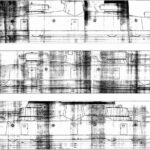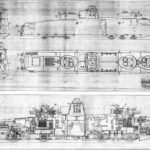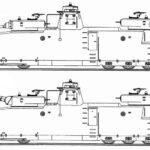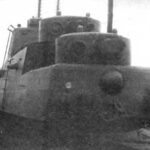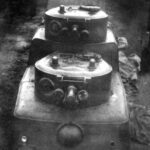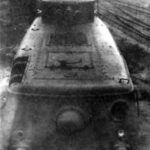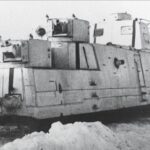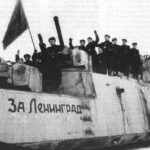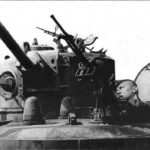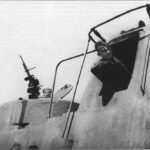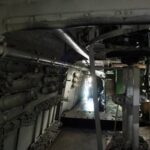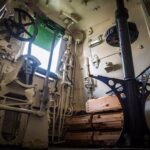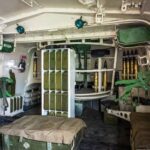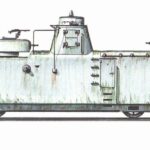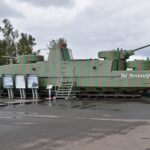The MBV-2 model is here
In the early 1930s, Russian military strategists sought an alternative to the massive armored trains engaged during the First World War and civil war. The increase in performance of the petrol engines made possible the motorization of armored vehicles on rail which without reaching the possibility of towing an entire armored train allowed at least to consider the manufacture of more or less imposing railcars. Note that one of the arguments was also a greater discretion with the disappearance of the large cloud of coal smoke. The idea was that in the event of success of this type of equipment, it would gradually supplant the old, less discreet and much heavier armored trains. Various shipyards in the USSR were given the task of developing these machines (Lugansk and Orsk for the MBV-D2 of the NKVD, Moscow for the BDT-35 and DTR series, Leningrad for the MBV-2 project). Work on the latter began in June 1935 at the Kirov plants in Leningrad in the SKB-2 department. OM Ivanov led the research office before being accused of being part of the Trotsky-Zinoviev connection during the purges and being executed on May 7, 1937. The first prototype was presented to the military authorities on November 07, 1936 and early 1937, it was decided to test it on 5000 km. These tests proved disappointing, showing the weaknesses of the frame and the boggies and causing modifications until February 1937 when other tests were practiced on February 12th on the Leningrad-Pskov railway line. After these tests, the No. 1 was put at disposal to the commander of the armored troops Bubnov in Leningrad. At the end of June 1939, he was sent to the Kolomna factory for modernization where he was still at the time of the German invasion of June 1941. At the same time, the factory was still building the second copy under the direction of the engineer Smirnov while adapting as and when changes made. It was planned to install new conical towers for 76,2 mm PS-3 guns, possibility to switch to west european gauge, strenthen the gearbox, mount a new telephone, install smoke alarms, surveillance devices, etc… This second model was accepted by the authorities on April 17, 1937 and began its tests. Despite the difficulties encountered, it was decided to produce a first batch of 10 MBV-2 in the same Kirov factories but the work was stopped while the chassis and the gearbox of a third vehicle were finished, as well as the structure of four others.
The armored railcar was called MBV-2. Two copies were built. It included both land armament in the form of three turrets coming directly from an armored tank in service: the T28 (note that the T28 was built in these same yards) and an anti-aircraft armament under the Quadruple carriage of Maxim machine guns positioned under a large hatch in the crate. T28 turrets were initially armed with short 76.2 mm KT-28 guns PS-3 and then later versions L-11 and F-34. The secondary armament included several 7.62 mm DT machine guns on both sides of the superstructure and in T28 turrets. The ammunition carried was plethoric with 365 shells of 76.2 mm, 10962 bullets for the machine guns DT and 22000 for the Maxims. The crew consisted of 40 men. The armor of the superstructure ranged from 10 mm for the roof to 16 to 20 mm for the sides and the front and rear faces. The weight was 80 t and the theoretical maximum speed was 120 km / h, in practice 80 km / h, the propulsion being provided by the 400 hp diesel engine M17-T which also fitted the T28. The power was transmitted to the rear bogies while the front bogies only served as support.
With the German invasion of June 1941, both machines were engaged in combat.
The MBV-2 No. 1:
MBV-2 No. 1 was still under modernisation in the Kolomna factories on June 22, 1941.
On July 25, 1941 he was transferred to Moscow in the Podolsk factories and put at the disposal of the armored train reserve regiment.
In December 1941 he was made available to the 30 Armored Train Division (ODBP).
on February 28, 1942, the 30th ODBP was transferred to the North West Front and on March 5th was part of the 34th Army.
Between March 6 and 18, 1942, he supported the offensive around the Lychkovo station. On the last day he was attacked by JU88 bombers and returned to the Yaroslav locomotive factory for repairs.
On May 23 the 30th ODBP left for Moscow and from there was transferred to the 28th Army in the Stalingrad sector. On August 20, she arrived at Astrakhan and on August 27 crossed the Volga to position at the junction of the Fronts of Stalingrad and North Caucasus.
On April 15, 1943, the division passed to the 44th Army on the Southern Front and took into account the area of Rostov – Taganrog where it supported the offensive on Taganrog in August.
From 25 September to 7 December 1943, MBV-2 No. 1 was repaired in the Tambov locomotive factory, then joined the 30th ODBP which was part of the 51st Army of the 4th Ukrainian Front and up to the month from April 1944 harassed the German positions of the Chongarski Isthmus.
From 9 to 11 April 1944 he supported the attack on the Isthmus and followed the Russian forces invading Crimea. After the liberation of Crimea in May 1944, he was subordinated to the Independent Coastal Army based in Simferopol.
The MBV-2 No. 2:
In 1939, MBV-2 No. 2 was at the Moscow Deposit No. 37 when it was decided to test it in combat against the Finnish army (the Russo-Finnish War breaks out on November 30, 1939 and continues until March 13, 1940).
After repairs to the Kirov shipyards from 22 December 1939 to 4 January 1940 and the training of his crew, he was sent to the Karelian Isthmus at the disposal of the 7th Army of the North-West Front. MBV-2 was used independently to support Russian troops in the Perk-Jarvi area.
On March 8th he joined the 8th ODBP.
From March 10, he took over the Finnish positions in the Liimatta area.
After the war, he was sent back to Moscow for reinstatement.
At the announcement of the German invasion of June 1941, the MBV-2 No. 2 was quickly prepared.
On July 20, 1941, he joined the No. 60 armored train. From early August, he supported Russian troops in the area of Kingisepp Moloskovitsy Yastrebino.
On 13 August he was attacked by German artillery who destroyed the railway but managed to withdraw.
On 18 August, the MBV-2 and the No. 60 armored train were transferred to the Chudovo region where they were integrated into Major Golovacheva’s armored group. From the 21st to the 29th of August, he supported the troops of the 48th Army.
On August 30, he was repaired in Leningrad and was sent to Kirishi where he passed under the subordination of the Volkhov front.
In September 1941, he went into repairs again with, among other things, the replacement of his cannons with more efficient L-11 models.
In October 1941, he was assigned to the 3rd platoon, 1st battalion, 12th armored train regiment under the command of Lieutenant Konovalov.
In November 1941, he was sent to the Pontonnaya – Sapermaya region to support the « Narodniy Mstitel » or « revenge of the people » armored train.
In May 1942, the 71st Armored Train Division (ODBP) was established with the trains « Narodniy Mstitel » and « Stalinets-28 » and the MBV-2 under the direct control of the 55th Army.
In February 1943, the MBV-2 was assigned to the 14th special division of armored trains (MBV-2 No. 2 « Stremitelniy » (impetuous), and former armored train No. 30 renamed « Stoikiy » (firm)) to support the 23rd Army defending the isthmus of Karelia. The crews were made up of sailors from the Baltic Fleet.
In 1943, the L-11 guns were replaced by higher-performance F-34 models from the T34 tank.
The MBV-2 No. 2 returned to combat in the fall of 1943 supporting the 67th Army and in December 1943 the 53rd Army participating in the break-up of the Leningrad blockade in January 1944.
In May and June 1944, he was then engaged in the 21st Army’s offensive against Sestroretsk and then in the Battle of Vyborg as a mobile artillery to cover the 142th Infantry Division, then in the operations around Narva and Tallin under the control of the 2nd Army.
On 6 February 1945 he was stationed at Vyborg where he remained until 10 June 1945 and was transferred to Leningrad.
After the war, the No. 2 MBV-2 was transferred to the 65th railway depot in 1948 for modification. These included the engine changeover for a V-2 model, a new electrical system, new radio, a modernized control system and the dismantling of the quad quadruple Maxim machine gun. After all these modifications, in August 1951, the vehicle was tested on a 100 km route between Bryansk and Trozan, then again in May 1952, on a route of 180 km between Bryansk and Novaya. The engine overheated, it was removed for repairs but they were not executed and the train was sent to the Kubinka polygon where we can still see it today.

